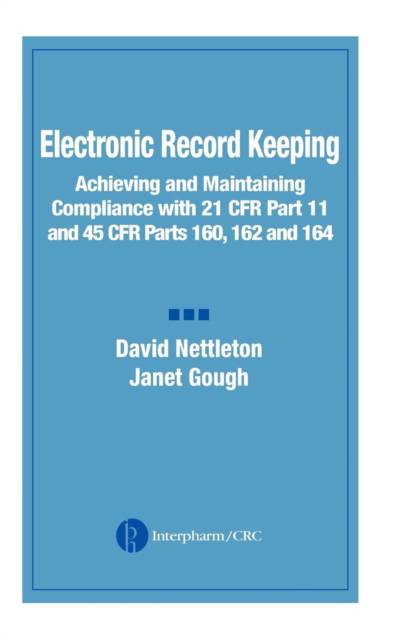
Je cadeautjes zeker op tijd in huis hebben voor de feestdagen? Kom langs in onze winkels en vind het perfecte geschenk!
- Afhalen na 1 uur in een winkel met voorraad
- Gratis thuislevering in België vanaf € 30
- Ruim aanbod met 7 miljoen producten
Je cadeautjes zeker op tijd in huis hebben voor de feestdagen? Kom langs in onze winkels en vind het perfecte geschenk!
- Afhalen na 1 uur in een winkel met voorraad
- Gratis thuislevering in België vanaf € 30
- Ruim aanbod met 7 miljoen producten
Zoeken
Electronic Record Keeping
Achieving and Maintaining Compliance with 21 Cfr Part 11 and 45 Cfr Parts 160, 162, and 164
David Nettleton, Janet Gough
Hardcover | Engels
€ 198,45
+ 396 punten
Omschrijving
The current revolution in software, and the regulations that have evolved to address it, have increasingly caused companies to turn to off-the-shelf software for electronic record keeping. Data captured in computerized systems must be as reliable, if not more so, than data on paper. Electronic Record Keeping: Achieving Compliance with 21 CFR Part 11 and 45 CFR Parts 160, 162, and 164 explores how to evaluate, select, implement, and document an e-system that will keep your organization in compliance. Covering Title 21 of the Code of Federal Regulations (CFR) Part 11 and the parallel, recently passed Title 45 CFR Parts 160, 162, and 164 of the Health Insurance Portability and Accountability Act (HIPAA), this book provides guidance for selecting, purchasing, installing, validating, and managing commercial off-the-shelf software for data collection and retention. It takes a number of years for industry standards for a new regulation to develop from dialog between companies and the regulating agency. These standards are in place for Part 11, which was passed into law in 1997. Healthcare providers who must implement electronic record keeping can learn how to best do it by understanding the parallel between the new HIPAA regulations and the industry standards for Part 11. Further, certain FDA-driven activities, such as patient record keeping in clinical trials, now must comply with the new HIPAA regs as well. To help companies achieve and maintain compliance, the authors cover audit trails, validation, documentation, training, and security and accountability. They discuss what the regulations say and what they mean. Compliance may be mandatory, but it also makes good business sense. Companies that are compliant will always be poised to move forward, and they will avoid the grief that comes from poor or faulty record keeping and documentation. This book gives you the tools you need to keep your company both compliant and competitive.
Specificaties
Betrokkenen
- Auteur(s):
- Uitgeverij:
Inhoud
- Aantal bladzijden:
- 384
- Taal:
- Engels
Eigenschappen
- Productcode (EAN):
- 9780849321641
- Verschijningsdatum:
- 29/12/2003
- Uitvoering:
- Hardcover
- Formaat:
- Genaaid
- Afmetingen:
- 154 mm x 248 mm
- Gewicht:
- 657 g

Alleen bij Standaard Boekhandel
+ 396 punten op je klantenkaart van Standaard Boekhandel
Beoordelingen
We publiceren alleen reviews die voldoen aan de voorwaarden voor reviews. Bekijk onze voorwaarden voor reviews.









